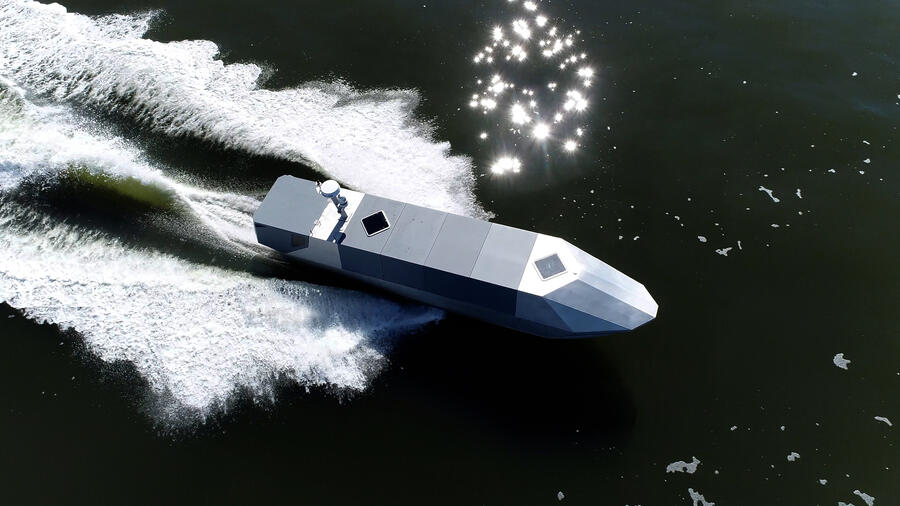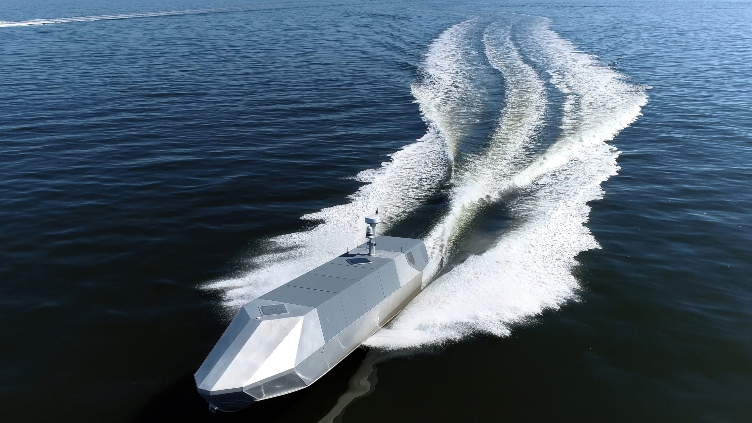Sea Archer Sets Standard for Small Unmanned Surface Vessels
It can zip along the ocean at 40 knots, carve a tight 180-degree turn, launch with a boat trailer and a pickup truck, and can fuel up at ordinary gas stations and marinas. But it’s not exactly your standard speed boat: it also boasts a range of 1,500 miles, carries 2,000 pounds of enclosed payload and runs with no one onboard. This unique vessel is Sea Archer.
Sea Archer is Leidos’ newest unmanned surface vessel (USV), providing exceptional performance and payload features in a small, affordable package. Coming off successful initial sea trials, Sea Archer is poised for mission tests and high-volume production.
“Sea Archer brings together a unique naval architecture, autonomy and relevant payloads into a complete mission system,” said Drew Mutch, USV program manager at Leidos. “It’s a ready-to-go functional tool for the warfighter.”
“Sea Archer combines a superbly engineered vessel with LAVA [Leidos Autonomous Vessel Architecture] autonomy to provide unprecedented, fully autonomous capability in a small, multi-role platform,” added Chuck Fralick, chief technology officer of sea systems at Leidos. “This is the same autonomy Leidos has set autonomous endurance records with on board its 132-foot Sea Hunter and Seahawk platforms, that sailed in portions of the Pacific in 2024 with no humans on board.”
Lava has now been integrated on board 12 different surface platforms at Leidos.
Performance, affordability and scalability
The 37-foot-long Sea Archer, whose development has been entirely funded by a Leidos research and development investment, addresses the growing need for USVs that can perform a range of missions from intelligence to interdiction.
Sea Archer brings together a unique naval architecture, autonomy and relevant payloads into a complete mission system. It’s a ready-to-go functional tool for the warfighter.
Drew Mutch
Leidos Unmanned Surface Vessels Program Manager
Sea Archer’s affordability and scalability are key to its utility. The war in Ukraine has provided striking evidence of the impact that large numbers of small, relatively inexpensive unmanned platforms can have in a conflict.
“A USV like Sea Archer will make a huge difference,” Mutch said.
But meeting the size, performance, affordability and scalability goals of Sea Archer was a daunting challenge — all the more because Leidos set a goal of designing, building and testing the craft in just one year.
That difficult assignment fell to the Leidos naval architecture division, which specializes in designing high-performance craft. The job came with some significant constraints:
- the boat needed to be built with simple, rugged, proven components to increase reliability and decrease maintenance costs;
- it had to be able to be produced in any boat yard; and
- it had to run on diesel fuel, which the U.S. military has increasingly relied on as a safer, readily available standard.
“If you run on diesel, you can refuel at just about any armed forces forward resupply,” Mutch said.
The hull design was particularly tricky because it had to provide the space and strength to handle at least one ton of enclosed payload, while at the same time conferring high speed and maneuverability. And don't forget the stability needed to keep the boat balanced, even at high speeds in rough seas.
“No one had ever done all that before,” Mutch said. “It called for both technical mastery and artistry.”
Power, meanwhile, would come from twin diesel outboards, which would keep operating and maintenance costs down while adding to maneuverability, range and transportability.
The swarm advantage
Less than a year after the project was green-lit, Sea Archer was in the water for testing, where it soon proved that all design goals had been met. To achieve its 1,500-mile range, the craft’s unique design enables it to travel with fuel making up an extraordinary one-third of its weight, without compromising performance or payload capacity.
“It was carefully engineered to safely carry twice as high a fuel-fraction as other long-range vessels,” Mutch said, “and it does so without stability, trim or balance problems.”
In addition, the Sea Archer’s materials and shape were designed for stealth.
Mutch points out that the affordability and large-scale manufacturing readiness of the Sea Archer means that the craft could be deployed in missions as a swarm — a tactic that has proved highly effective in the Ukraine war.
“Any vessel can be targeted by a group of missiles,” he said, “but you can’t launch enough missiles to stop a swarm of USVs.”
He added that the craft’s compact size and rugged build allow for easy logistics, including use of containers approved by the International Organization for Standardization (ISO).
Any vessel can be targeted by a group of missiles, but you can’t launch enough missiles to stop a swarm of USVs.
Drew Mutch
Leidos Unmanned Surface Vessels Program Manager
Next up for the Sea Archer is demonstrating mission capabilities with payloads on board, scheduled for later this year. After that, Leidos will be ready to start producing the craft at an initial rate of about 10 per month.
“We will demonstrate a number of mission payloads over the next several months that are relevant to the warfighter including electronic, kinetic and surveillance,” Fralick said.
There has been a persistent long-term vision of USVs of all sizes forming an integral part of the U.S. Navy fleet going forward.
“Sea Archer is a great example of the type of small USV the Navy will need in volume to fight the fight in the future. It brings innovation in design, leading to superior performance at affordable cost and great flexibility,” Mutch said.





